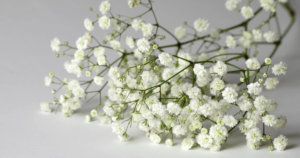Flowers are very sensitive and temperamental. They can be extremely picky about their environment. Managing their surroundings, especially temperature, is important to keeping your blooms looking their best for your big event.
Keeping Your Cool Correctly
A florist’s flower refrigerator is usually set to 35 degrees to 38 degrees F with a much higher humidity than food refrigerators. Most flowers actually perspire through their petals so keeping them cool and moist slows their respiration and extends their life. Your home refrigerator has a much lower humidity and will cause your flowers to dry out more quickly. And the food stored in your home refrigerator actually is slowly decaying and spewing off decay microbes. I know, eeww, but true. This will cause your flowers to decompose more quickly as well. Corsages and boutonnieres can be exceptions to the rule against storing flowers in a food frig. This because they are usually kept in clear plastic boxes that help retain moisture and protect the blooms from microbes and gases that could be circulating in a food refrigerator.
Your safest bet is to have your florist deliver your bouquet and table arrangements to your event location the day of the event. If you decide to pick up your flowers yourself, it is best to get them as late as possible the day before. Keep them in a cool, dark place away from drafts and direct sunlight as both will cause wilting. A wine cellar or even a food cellar could work well.
Too Cold Can Kill
A garage or carport when the outside temperature is freezing is not a good substitute for a refrigerator for flowers. If the temperature is too cold, the water inside the flowers will freeze killing the blossoms immediately.
If you are having a winter event and want outside photos in the snow, we recommend scheduling these shots last. Your bouquet will not last long when temperatures are at or below freezing. The damage caused by excessive cold is seen quickly and is irreversible.

How to Handle the Heat
Heat is another problem for flowers. In recent years in Idaho and the Pacific Northwest, temperatures have reached triple digits during the summer. For most cut flowers, warmer temperatures mean shorter life. Any temperature above 90 degrees is too hot for most flowers and will greatly accelerate wilting. In the 2022 season we had an event at The Ridge at Greenbluff during an unexpected extreme heat wave. Knowing that their arbor was in direct sunlight, we called ahead a rescheduled our delivery to a little later in the afternoon. We also reworked the design a bit to remove the hydrangeas, which are particularly heat sensitive flowers.
Florists also have a little trick they use in hot months when high temps can make timing dicey. It’s a special spray to use on the blooms. We like to call it “flower antiperspirant” because it stops flowers from sweating and loosing moisture. This can help them last longer in the heat.
When a Little Heat Can Help
A little warmth can be useful with some flowers such as peonies and lilies. These flowers are shipped with closed buds, so their bloom opening needs to be timed to the event. Warmth encourages bud opening, but then the flowers must be returned to a cool, moist environment of a proper floral refrigerator to maintain those fresh blossoms. Tropical flowers also prefer warmer temperatures of about 50 to 55.
Be careful to treat your blooms kindly because unfortunately wilting is often not seen until the time you want everything to look its best—when you are walking down the aisle, getting photos taken or guests are being seated at tables. Temperature control and timing are keys keeping your floral arrangements looking their best for your big event.



